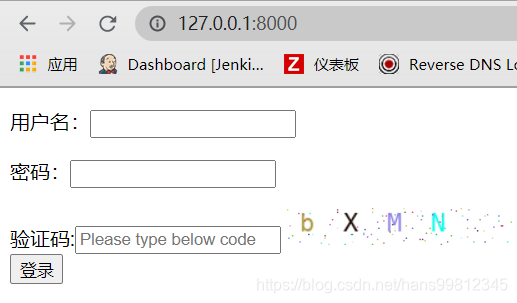首先在项目里建立common目录,编写验证码的函数
verification_code.py
import random
from PIL import Image, ImageFont, ImageDraw
def get_code():
mode = 'RGB'
bg_width = 180 #这个是验证码那个框框的宽度
bg_height = 30 #这个是验证码那个框框的高度
bg_size = (bg_width, bg_height)
bg_color = (255, 255, 255)
ttf_path = 'config/DejaVuSansMono.ttf'#这个是字体,从linux里扒出来饿字体
# ttf_path = '/usr/share/fonts/truetype/dejavu/DejaVuSansMono.ttf' #这个要换你服务器里有的字体才行
img = Image.new(mode, bg_size, bg_color)
draw = ImageDraw.Draw(img, mode)
font = ImageFont.truetype(ttf_path, 20)#这个俺也没懂
# generate text
letters = get_letters()
for index, text in enumerate(letters):
x = 35 * index + 10 #这个好像是调那个字符间距的
y = 0
draw.text((x, y), text, get_rdmcolor(), font)
# blur the background
for i in range(100): #这个是设置干扰线的,数值越大,干扰的越厉害
x = random.randint(0, bg_width)
y = random.randint(0, bg_height)
fill = get_rdmcolor()
draw.point((x, y), fill)
return img, letters
def get_letters(): #这个就是从下面这些字母里去随机4个出来
base = '1234567890qwertyuiopasdfghjklzxcvbnmQWERTYUIOPASDFGHJKLZXCVBNM'
result = []
for i in range(4): #这个是4位,应该改更多位,那么上面的参数还要调试,不然显示有问题
result.append(random.choice(base))
return result
def get_rdmcolor():
return random.randint(0, 255), random.randint(0, 255), random.randint(0, 255)
模板
<!DOCTYPE html>
<html lang="en">
<head>
<meta charset="UTF-8">
<title>Title</title>
</head>
<body>
<form method="POST" action="login/">
<p>用户名:<input type="text" name="user"></p>
<p>密码:<input type="text" name="pwd"></p>
<label for="verification_code">验证码:</label><input type="text" name="verification_code"
placeholder="Please type below code">
<img class="identifyCode" title="点击重新获取" onclick="this.setAttribute('src','verification_code?random='+Math.random())" src="{% url 'verification_code' %}" alt="verification code">
<br>
<input type="submit" value="登录">
</form>
<script>
</script>
</body>
</html>
onclick="this.setAttribute('src','verification_code?random='+Math.random())"
这个 onclick事件 就是实现点击图片刷新验证码功能 ,那为啥要加个随机数呢,这样就不会走浏览器缓存了
urls.py
from django.urls import path
from test_login_app import views
urlpatterns = [
path('',views.index),
path('verification_code/', views.verification_code, name='verification_code'),
path('login/',views.login),
path('index/',views.index2),
]
views.py
from io import BytesIO
from django.http import HttpResponse
from django.shortcuts import render, redirect
from common.verification_code import get_code
# Create your views here.
def index(request):
return render(request, 'login.html')
def verification_code(request):
img, letters = get_code()
request.session['verification_code'] = ''.join(letters)
fp = BytesIO()
img.save(fp, 'png')
return HttpResponse(fp.getvalue(), content_type='image/png')
def login(request):#我这个没跟数据库联动,简单模拟的逻辑
if request.method == 'POST':
name = request.POST.get('user')
password = request.POST.get('pwd')
code = request.POST.get('verification_code')
if name == 'fuck' and password == 'xxoo' and code == request.session.get('verification_code', ''):
return redirect('/index/')
return render(request,'login.html')
def index2(request):
return render(request,'index.html')
成品如图

js


